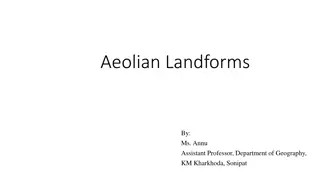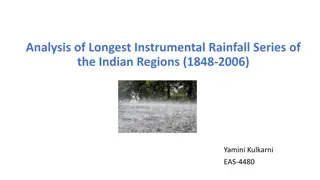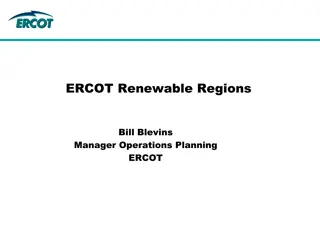Understanding Alluvial Fans: Formation, Characteristics, and Morphology
Alluvial fans are cone-shaped landforms formed by streams carrying sediments from mountains onto plains. They are prominent in arid to semi-arid regions and vary in size from a few meters to over 150 kilometers. The different zones of an alluvial fan, including the fan apex and distal fan, display d
5 views • 9 slides
Aeolian Landforms: Shaping Earth's Surface Through Wind Action
Geomorphic processes, including aeolian processes, play a significant role in modifying the earth's surface. This article delves into how wind erosion and deposition create unique landforms such as ventifacts and yardangs. Understanding the transportation methods and topographic effects of wind eros
0 views • 22 slides
Climate and Climatic Regions of Pakistan
Pakistan exhibits diverse climatic regions ranging from sub-tropical continental mountains to arid desert plateaus. Factors like altitude, latitude, and distance from the sea greatly influence the country's climate. The country experiences weather conditions such as temperature variations, rainfall
0 views • 14 slides
Understanding Regions in Geography
Regions in geography are defined by common features such as climate, landscape, language, or religion. They serve as basic units of geography, with the Middle East being a notable example encompassing political, environmental, and religious characteristics. Regions can be classified based on physica
0 views • 10 slides
Understanding Regional Planning and Economic Regions in Geography
Regional planning involves defining regional units, planning regions, and economic regions to ensure sustainable development. It focuses on creating suitable areas for population and employment distribution. The characteristics of planning regions include resource homogeneity, internal coherence, an
0 views • 16 slides
Harnessing Bamboo for Sustainable Agriculture in Somalia
The Horn of Africa Peace Network (HAPEN) is piloting bamboo cultivation in Kismayo and Belet Hawa to combat desertification and promote sustainable agriculture. Bamboo, a versatile plant, offers a renewable resource that can thrive in various climates, including the arid regions of Somalia. The init
0 views • 5 slides
Population Resource Regions and Zelinsky's Classification
Geographers have long studied the relationship between population growth and resource adequacy, leading to the concept of Population Resource Regions (PRR) by W. Zelinsky. Zelinsky identified five types of PRR based on population-resource ratios, ranging from Type A with high resource utilization po
0 views • 8 slides
Population Distribution in Different Regions of Pakistan
The population distribution in Pakistan varies significantly among different regions, with certain provinces like Punjab and Sindh having higher population densities compared to Baluchistan and FATA. The rural areas are also categorized into different population density regions based on the number o
0 views • 14 slides
Aeolian Landforms and Processes: A Geographical Study by Ms. Annu
Geomorphic processes are crucial in shaping the Earth's surface, with Aeolian processes driven by wind erosion, transportation, and deposition. This study explores the topographic effects of wind erosion, transportation methods, and the formation of Aeolian landforms like ventifacts and yardangs. Th
0 views • 22 slides
A Comparative Overview of World Cultural Regions
Explore the various types of cultural regions and their characteristics around the world, including North America, Latin America, the Middle East, Sub-Saharan Africa, and Europe. Discover how these regions differ in terms of language, religious beliefs, customs, and art forms, providing insight into
1 views • 22 slides
Geography and Five Regions of Wisconsin: Key Points and Natural Features
Wisconsin's geography is influenced by the Great Lakes and the Mississippi River, affecting population distribution based on topography, soil, and climate. The state's historical reliance on soil resources for fur trade, lumber, farming, and manufacturing is evident. Varied regions like the Driftles
3 views • 9 slides
Challenges Faced in Isiolo County, Kenya's Arid Region
Isiolo County in Kenya, characterized by arid and semi-arid lands, faces challenges related to fragile ecosystems, climate change impact, land use competition, breakdown of traditional resource systems, and tribal conflicts. This poses threats to the nomadic pastoral way of life and sustainable land
0 views • 10 slides
Pearl Millet - Overview, Economic Importance, and Cultivation
Pearl millet (Pennisetum glaucum L.) is a vital coarse grain crop, known for its drought tolerance and nutritional value. Also called bajra, it serves as staple food, poultry feed, and cattle fodder. Originating from Africa, pearl millet is widely cultivated in semi-arid regions of India, Africa, an
7 views • 22 slides
EU Coal Regions Exchange: Pitch Presentation Guidelines for Matchmaking Session
In the upcoming matchmaking session on December 10th, 2021, representatives from EU coal regions will have the opportunity to pitch their ideas for potential exchanges and engage in discussions. Participants are required to prepare a formal pitch slide by December 6th, stick to a strict 90-second ti
0 views • 4 slides
Comparison of Convective Cores in Gulf and Plains Regions
A detailed comparison of convective cores between Gulf and Plains regions across different seasons reveals interesting patterns. Gulf storms have more cores in the fall, with larger sizes and more cores in winter. The Plains see more cores in the spring season and have generally bigger storms year-r
1 views • 4 slides
Euroscepticism in Border Regions: The Identity Crisis of Europe
Euroscepticism in border regions reflects frustration, disillusionment, and disengagement with the European idea at the borders of the EU. The identity crisis of Europe is showcased through sentiments of dissatisfaction and detachment towards the EU, as evidenced in various border regions. This phen
0 views • 29 slides
Wind as a Geologic Agent in Shaping Landscapes
Wind has played a significant role in shaping landscapes during times of drier climates, being a key geologic agent impacting erosion and deposition processes. The global wind system, driven by factors such as heating from the sun and the rotation of the Earth, creates convection currents that circu
0 views • 31 slides
Enhancing Restoration Success with Seed Pellets: A Study on Predicting Germination in Arid Environments
Ecological restoration in arid lands often faces challenges with seeding projects. This study explores using seed pellets to predict germination success by matching seed traits with pellet characteristics. The hypotheses focus on seed size and species comparison to improve restoration practices.
0 views • 13 slides
Analysis of Longest Instrumental Rainfall Series in Indian Regions
This study by Yamini Kulkarni analyzes the longest instrumental rainfall series in Indian regions from 1848 to 2006. It includes the development of rainfall series for different zones using a network of rain gauge stations and statistical methods to understand fluctuations in precipitation over a 15
0 views • 9 slides
Analysis of CHyM Model Performance in Different Regions
The study evaluates the performance of the CHyM model in humid and arid regions, specifically focusing on Tropical South America and Central America. Through analyzing simulated values, seasonal behavior, and response to ENSO phases, the study provides insights into water resource management in thes
0 views • 16 slides
Enhancing Region Search Queries with Content and Spatial Similarity Measures
This project focuses on developing a system to provide top-k similar regions on a map based on user-specified query regions. By incorporating content and spatial similarity measures, the algorithm aims to accurately retrieve regions with similar shapes, scales, and representative categories. Challen
0 views • 12 slides
Integrated Drought Risk Management in Latin America and the Caribbean
Managing water resources in arid and semi-arid regions of Latin America and the Caribbean involves addressing climate risks through integrated drought risk management. Tools such as National Drought Observatories, Latin American Flood and Drought Monitor, and the Latin American Drought Atlas aid in
0 views • 14 slides
Rainfall-Runoff Simulation in Semi-Arid Area Using Distributed CHyM Model: DEZ River Basin Study
This case study delves into the simulation of rainfall-runoff using the CHyM model in the semi-arid area of the DEZ River Basin in Iran. The study focuses on water resources management, flood control, and forecasting of flood discharge parameters, emphasizing the importance of accurate modeling for
0 views • 22 slides
The Impact of Artists and Creatives in Border Regions on Culture and Economy
Artists and creatives play a crucial role in the cultural and economic landscape, particularly in border regions where diverse cultures intersect, fostering creativity and innovation. Despite facing challenges, they significantly contribute to social cohesion, the European economy, and the cultural
1 views • 21 slides
Visualization of Crude Birth Rates in European Regions
Explore the visualization of crude birth rates in different European regions using cartography and distribution plots. The data, sourced from Eurostat Regional Statistics, illustrates variations across regions, with France showing both the lowest and highest rates relative to other European countrie
0 views • 4 slides
Effectiveness of Forecast-Based Financing in Emergency Response: A Case Study of West Pokot County, Kenya
Extreme weather conditions are increasingly impacting regions worldwide, especially arid areas like West Pokot County, Kenya. To address these challenges, the Kenya Red Cross Society implemented a Forecast-Based Financing (FBF) system in partnership with the FBF technical working group. By testing t
0 views • 14 slides
Understanding Ionospheric Absorption Laws and Regions
The principles of the ionosphere at middle and low latitudes, Lambert-Beer exponential absorption law, and characteristics of E and F regions are discussed. The absorption of solar radiation, recombination reactions in different regions, and ionization processes are highlighted, providing insights i
0 views • 15 slides
Discovering South America: Landscapes and Resources
Explore the diverse regions of South America, from the majestic Andes Mountains to the arid Atacama Desert, the vibrant countries of Bolivia, Brazil, Colombia, and Mexico, and the rich tapestry of Latin America. Learn about the physical features and natural resources that make these areas unique and
0 views • 19 slides
Investigating Dust Storm Frequency and Extreme Drought Relationship in Arid Regions of Iran
This research by Reza Modarres and Poria Mohit Isfahani from Isfahan University of Technology explores the temporal changes in dust storm frequency in arid regions of Iran, examining how drought impacts the frequency in changing environments and the relation between extreme droughts and dust storm o
0 views • 14 slides
Collaborative College Regions Mapping Tool for Educational Improvement
Explore the collaborative efforts between various colleges and regions in Scotland through this comprehensive mapping tool. Gain insights into partnerships, initiatives, and regions working together for educational improvement. Visualize the connections and collaborations enhancing the educational l
0 views • 7 slides
Biologically Important Evening Element in Promoter Regions: Insights from Research by Leila Shokat
The research explores the significance of the Evening Element as a motif in gene promoter regions regulated by CCA1. Understanding the importance of motif positions in promoters reveals insights into gene regulation and biological relevance. The study highlights the relevance of consistent motif pos
0 views • 6 slides
Understanding Deserts and Desertification: Lecture Insights by Maher M. Mahdi
Delve into the world of deserts and desertification with valuable insights collected by Maher M. Mahdi. Explore definitions of deserts, steppe regions, and semi-arid climates. Learn about the dryness ratio, distinguishing factors between true deserts and semi-deserts, and Budyko-Lettau dryness ratio
0 views • 22 slides
Euroscepticism in Border Regions: A Deep Dive into Cross-Border Practices and Perceptions
Explore the phenomenon of Euroscepticism in border regions, delving into cross-border practices and perceptions at the EU's internal borders. This study sheds light on how border regions emerge both functionally and institutionally, emphasizing the importance of understanding Euroscepticism in these
0 views • 16 slides
The Behavior of Spotless Active Regions During Solar Minimum
In this work presented at the SPAnet Workshop on Radio Astronomy in 2017, the study analyzed the physical parameters of spotless active regions observed during the solar minimum period from 2007 to 2010. Radio maps at 17 GHz from the Nobeyama Radioheliograph and magnetograms from the Michelson Doppl
0 views • 14 slides
Water Harvesting Techniques in Rainfed Agriculture & Watershed Management
Water harvesting plays a crucial role in rainfed agriculture by collecting and storing runoff water for irrigation in arid and semi-arid regions. Mr. Anil Swami, an assistant professor, discusses the importance of water harvesting techniques, including runoff farming and rainwater harvesting. He emp
0 views • 13 slides
Understanding Desertification: A Global Environmental Challenge
Desertification is a pressing issue affecting over a billion people globally, with drylands covering a significant portion of the Earth's surface. This phenomenon leads to the degradation of ecosystems and poses severe challenges for inhabitants of arid regions. Major deserts like the Sahara and Ara
1 views • 21 slides
Overview of ERCOT Renewable Regions and Zone Map
ERCOT, managed by Bill Blevins, divides into seven solar and wind regions including North, South, East, West, Panhandle, Coast, and Houston. This division aids operations planning and management. The Renewable Regions Map and Zone Map play key roles in GIS status reporting and meeting presentations,
0 views • 4 slides
Geography of Africa South of the Sahara - Physical Features, Climate, and Economy
Explore the physical geography of Africa south of the Sahara, including features like fault lines, savannas, deltas, and escarpments. Learn about the effects of harmful actions on the environment like desertification. Discover the diverse climate regions, from wet tropical rainforests to arid desert
0 views • 23 slides
Understanding Aeolian Processes and Landforms
Aeolian processes are crucial in arid and semi-arid regions, involving erosion, transportation, and deposition by wind. Factors like wind velocity, grain size, rock composition, and vegetation influence erosion. Different types of wind erosion include deflation, abrasion, and attrition. The transpor
0 views • 18 slides
Unveiling the World of Dust: Origins, Movements, and Historical Perspectives
Dust, a fine-grained sediment, originates mainly from arid regions like deserts, with the Sahara being a major source. Carried by winds over vast distances, dust plays a crucial role in shaping landscapes and climate. The amount of dust in the atmosphere has fluctuated throughout Earth's history, wi
0 views • 12 slides







































